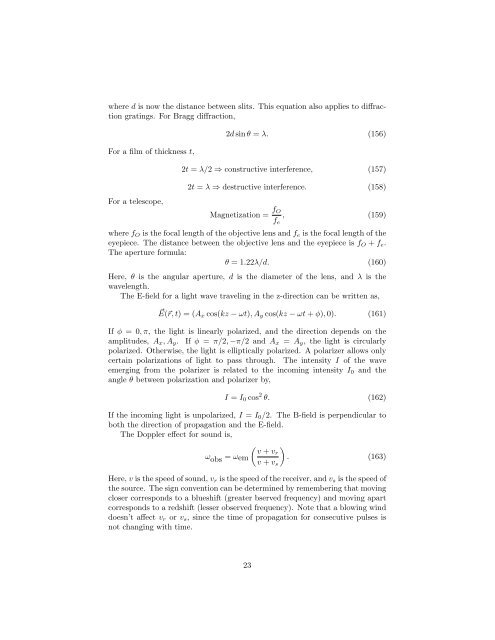Notes for the Physics GRE - Harvard University Department of Physics
Notes for the Physics GRE - Harvard University Department of Physics
Notes for the Physics GRE - Harvard University Department of Physics
You also want an ePaper? Increase the reach of your titles
YUMPU automatically turns print PDFs into web optimized ePapers that Google loves.
where d is now <strong>the</strong> distance between slits. This equation also applies to diffractiongratings. For Bragg diffraction,For a film <strong>of</strong> thickness t,For a telescope,2d sin θ = λ. (156)2t = λ/2 ⇒ constructive interference, (157)2t = λ ⇒ destructive interference. (158)Magnetization = f Of e, (159)where f O is <strong>the</strong> focal length <strong>of</strong> <strong>the</strong> objective lens and f e is <strong>the</strong> focal length <strong>of</strong> <strong>the</strong>eyepiece. The distance between <strong>the</strong> objective lens and <strong>the</strong> eyepiece is f O + f e .The aperture <strong>for</strong>mula:θ = 1.22λ/d. (160)Here, θ is <strong>the</strong> angular aperture, d is <strong>the</strong> diameter <strong>of</strong> <strong>the</strong> lens, and λ is <strong>the</strong>wavelength.The E-field <strong>for</strong> a light wave traveling in <strong>the</strong> z-direction can be written as,⃗E(⃗r, t) = (A x cos(kz − ωt), A y cos(kz − ωt + φ), 0). (161)If φ = 0, π, <strong>the</strong> light is linearly polarized, and <strong>the</strong> direction depends on <strong>the</strong>amplitudes, A x , A y . If φ = π/2, −π/2 and A x = A y , <strong>the</strong> light is circularlypolarized. O<strong>the</strong>rwise, <strong>the</strong> light is elliptically polarized. A polarizer allows onlycertain polarizations <strong>of</strong> light to pass through. The intensity I <strong>of</strong> <strong>the</strong> waveemerging from <strong>the</strong> polarizer is related to <strong>the</strong> incoming intensity I 0 and <strong>the</strong>angle θ between polarization and polarizer by,I = I 0 cos 2 θ. (162)If <strong>the</strong> incoming light is unpolarized, I = I 0 /2. The B-field is perpendicular toboth <strong>the</strong> direction <strong>of</strong> propagation and <strong>the</strong> E-field.The Doppler effect <strong>for</strong> sound is,( ) v + vrω obs = ωem . (163)v + v sHere, v is <strong>the</strong> speed <strong>of</strong> sound, v r is <strong>the</strong> speed <strong>of</strong> <strong>the</strong> receiver, and v s is <strong>the</strong> speed <strong>of</strong><strong>the</strong> source. The sign convention can be determined by remembering that movingcloser corresponds to a blueshift (greater bserved frequency) and moving apartcorresponds to a redshift (lesser observed frequency). Note that a blowing winddoesn’t affect v r or v s , since <strong>the</strong> time <strong>of</strong> propagation <strong>for</strong> consecutive pulses isnot changing with time.23
















